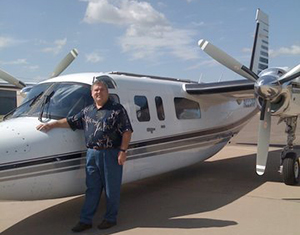Performance Tips from Pre-Flight to Landing

By Hugh Davis

Commander instructor Hugh Davis
Cooler temperatures are upon us! Severe weather is diminishing! It’s time to start thinking about new destinations in your Commander! Planning for a new route is exciting and time-consuming. It’s all part of a proficient pilot’s preflight, before he engages the Engine Start Switch, and includes pulling out the Pilots Operating Handbook, reviewing the route via the internet, doing some hangar flying, and reacquainting ourselves with the performance of the Twin Commander. As we clean out the cobwebs, we must remember it is a federal air regulation that we complete a proper preflight by determining required runway lengths, fuel requirements, and weather conditions.
During a recent ground school a few Commander pilots wanted answers as to the performance of a Dash 10T-converted aircraft. The talk flowed to such things as runway requirements, en route performance, and fuel economics. It’s important to understand all three of these factors.
Commanders that were delivered new from the factory with TPE331 Dash 5 engines (all 690s and 690As and Bs) have a horsepower rating of 717 hp, while the 690D models, which also had factory-installed Dash 5s, are rated at 730 hp. Many of these Dash 5 aircraft have been converted to Dash 10T’s with no change to the published performance charts in the Pilot Operating Handbook (POH).
For those aircraft that have been converted from the Dash 5 to the 10T, performance at sea level to a density altitude of 1,275 ft will be the same as for a Dash 5-powered aircraft. However, the 10T will begin to show its performance gains as density altitude increases, all the way up to its service ceiling.
With the installation of the TPE331-10T, the only change in the performance section of the Pilots Operating Handbook was a note that stated performance would be the same or greater. Therefore, no information was available to determine the runway or climb performance with 10T power. After several years of observation, many pilots have determined that their 10T-converted aircraft have very similar performance to the Twin Commander 695 (the 980), which was the first Commander model to have factory installed TPE331-10 engines.
For example, based on the accelerate-go distance chart, a gross-weight takeoff from Denver, Colorado, at a field elevation of 5,400 feet and ambient temperature of 70 degrees, would require a takeoff distance of 5200 feet in a Commander 840 (Dash 5-powered), and 4500 feet in a 980 (Dash 10-powered).
Another pilot flying a Commander asked about an approach and landing to a relatively short runway, Staniel Cay in the Bahamas, under somewhat challenging conditions.
Here is his scenario:
“I’m looking at flying to MYES, Staniel Cay in the Bahamas. The runway (17-35) is sea level, paved (typical Bahamas shell-asphalt with loose shell on the runway), 3,030 feet long and 75 feet wide with several hundred feet of overrun when landing 17, the primary runway. Prevailing wind typically out of the southeast, about 120 degrees, so there is usually a crosswind when landing 17. The crosswind comes over hills just to the left of short final, which makes for a rock-and-roll ride on very short final. Plus, there is a hill just off the approach end of the runway. So, this is a textbook approach to a short, narrow runway with a somewhat loose surface over a 50-foot obstacle with crosswind turbulence on short final. Given all of those conditions, what technique would you recommend?
My response would be: The POH states that, assuming a 30-degree day and no wind, runway required would be 2200 feet with reverse thrust and heavy braking, and 2400 feet with no reverse power. Airspeed would be charted speed based on landing weight. With the normal tradewinds I would add the entire steady-wind component and half of the gust. Gusty wind over 15 knots would make me reconsider an arrival there due to the desire to have a stable approach and being on speed at 50 feet at the approach end.
Prior to landing I would conduct a flyby and pick a touchdown point. Then, if not on the ground at that spot during the landing, I would go around. I would have to assume an aggressive landing (carrier type) and of course inform my passengers. After the nose wheel is on the ground I would use aggressive braking and reverse thrust. Make sure to retard reverse thrust at the end of the landing roll due to FOD on the runway.
One more piece of advice would be to practice your short-field landing technique on a longer runway until you have confidence in yourself and the Commander.
Reading the online Commander Community Forum (http://www.flightlevelsonline.com/phpBB/) there has been considerable discussion as to climb speeds for the Commander. Bob Hoover set three time-to-climb records on April 27, 1978 in a Turbo Commander 690B Dash 5-powered aircraft. He climbed to 3,000 meters (9,843 ft) in 2:21 minutes, 6,000 meters (19,685 ft) in 5:16 minutes and 9,000 meters (29,527 ft) in 9:43 minutes. Of course, this 690B was stripped down to the bare minimum with just enough fuel to get there and little reserve.
The Pilots Operating Handbook (POH) states that the best rate of climb is 139 knots at sea level (135 knots for the JetProp), and then decreasing by one knot per thousand in the climb. In many cases this best rate is a little uncomfortable for our passengers, and the view over the nose is limited. Any increase in speed over best rate will decrease the rate of climb, but it also will increase the true airspeed, resulting in a slight deduction in total time en route. Rate of climb and climb speed can also be controlled by outside factors such as ATC or terrain.
In reviewing the cruise performance charts for the 690s and all the JetProps, it is safe to say that the higher you fly the longer the range. There is some difference in range between long-range cruise and max cruise. For example, at 25,000 ft. a 690B on a standard day will have 75 more miles of range (1350 nmi) if the power is set for long-range cruise.
One of the best improvements to the Commander was the longer wing on the JetProps, which made for additional fuel-tank capacity. This increased the range to more than 2000 miles in the JetProp 1000. Since the last Commander rolled off the production floor in 1986, there has been a lot said about the performance of the Turbo Commander and what a great design it is. With the cost of ownership and fuel increasing, the design is even more competitive today.
There have been some interesting stories from pilots who have made long-distance flights. One owner bought his JetProp 900 (converted to Dash 10 power) here in the U.S. and flew it to Australia via the Pacific. Other owners have taken their Commanders from the U.S. to Europe. All of these long-range trips were flown near the service ceiling of the aircraft.
Figuring range and fuel consumption has been made a lot easier by flight planning websites like FltPlan.com, FlightAware.com, Duats, and Jeppesen. Most sites have the performance data already loaded into the software, and at some of the sites you can fine-tune their data with your own derived data. Even guesswork as to how winds and fuel cost will affect your total operating cost can be factored in. In some conditions based on computed data, flying into a headwind might be more appropriate. You may burn more fuel at a lower altitude, but total flight time will be less, therefore reducing total operating expenses.
Poor descent planning can end up burning a considerable amount of fuel that you had saved by flying high. On your next flight watch the fuel flow gauges during the descent. You will see that in the initial descent, reducing the power to 300 hp or around 30 percent torque will indicate a fuel flow (FF) of under 200 lbs per hour per engine. At lower altitudes you will see that the FF will continue to climb. Leveling the aircraft at 10,000 ft. or lower can easily increase the FF to more than 300 lbs per hour per engine. Most Commander pilots descend at a 1,500 feet per minute rate and 200 KIAS. Power will be set at around 300 hp or 30 percent torque.
Prior to your next flight spend time in the performance section of your aircraft’s POH, and create specific scenarios based on your flying. Remember, this not only is the regulatory requirement, but also what makes “The Proficient Pilot.”
Hugh Davis is a former FlightSafety International Commander instructor. He flies a 690B for an owner.
Discuss this article in the forums...







